Papers by Barbara Trudell
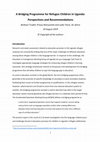
Research and needs assessment related to education provision in the Uganda refugee response are c... more Research and needs assessment related to education provision in the Uganda refugee response are consistently finding that one of the major challenges to effective education among these refugee children is the language barrier. In response to this challenge, the Education in Emergencies Working Group of Uganda set up a language Task Team to investigate appropriate language strategies for enhancing refugee children’s learning outcomes. One strategy of particular interest to the group is the development of a bridging programme that will allow children to span the language gap in education.
The present report is the result of a 10-week investigation into the language-related issues and challenges found in education provision for children in Uganda’s refugee settlements. The recommendations emerging from this investigation are based on collection and analysis of relevant documents, a wide range of stakeholder perspective, and approximately 90 hours of observation and interview activities in the Kyangwali and Imvepi refugee settlements of western and northern Uganda respectively.
The central recommendation of this investigation is the development and implementation of a Bridging Programme that will raise children’s oral English fluency, teach reading and writing in a language that the children speak, and enhance their mathematics skills. This Bridging Programme would be designed not to compete with other education programmes for refugees, but rather to deliver learners who can understand and benefit from further learning – so supporting refugee education initiatives and enhancing their success.
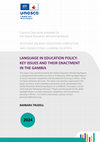
LANGUAGE IN EDUCATION POLICY: KEY ISSUES AND THEIR ENACTMENT IN THE GAMBIA. Country Case study prepared for the Global Education Monitoring Report SPOTLIGHT ON BASIC EDUCATION COMPLETION AND FOUNDATIONAL LEARNING IN AFRICA, 2024
This paper was commissioned by the Global Education Monitoring Report as background information t... more This paper was commissioned by the Global Education Monitoring Report as background information to assist in drafting the 2024 Spotlight Report on basic education completion and foundational learning in Africa. It has not been edited by the team. The views and opinions expressed in this paper are those of the author(s) and should not be attributed to the Global Education Monitoring Report or to UNESCO. The papers can be cited with the following reference: "Paper commissioned for the 2024 Spotlight Report on basic education completion and foundational learning in Africa". For further information, please contact gemreport@unesco.org. LANGUAGE IN EDUCATION POLICY: KEY ISSUES AND THEIR ENACTMENT IN THE GAMBIA Country Case study prepared for the Global Education Monitoring Report SPOTLIGHT ON BASIC EDUCATION COMPLETION AND FOUNDATIONAL LEARNING IN AFRICA
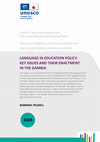
LANGUAGE IN EDUCATION POLICY: KEY ISSUES AND THEIR ENACTMENT IN THE GAMBIA, 2024
This paper was commissioned by the Global Education Monitoring Report as background information t... more This paper was commissioned by the Global Education Monitoring Report as background information to assist in drafting the 2024 Spotlight Report on basic education completion and foundational learning in Africa. It has not been edited by the team. The views and opinions expressed in this paper are those of the author(s) and should not be attributed to the Global Education Monitoring Report or to UNESCO. The papers can be cited with the following reference: "Paper commissioned for the 2024 Spotlight Report on basic education completion and foundational learning in Africa". For further information, please contact gemreport@unesco.org. LANGUAGE IN EDUCATION POLICY: KEY ISSUES AND THEIR ENACTMENT IN THE GAMBIA Country Case study prepared for the Global Education Monitoring Report SPOTLIGHT ON BASIC EDUCATION COMPLETION AND FOUNDATIONAL LEARNING IN AFRICA

Language in Education in Nigeria, Phase II: Report 2022, 2022
To better understand the dynamics and impact of language of instruction choices in Nigerian class... more To better understand the dynamics and impact of language of instruction choices in Nigerian classrooms, the Foreign, Commonwealth and Development Office (FCDO)/UK Aid has funded a two-phase study of the issues and opportunities related to language of instruction in the country. Phase I, which was facilitated by the British Council
and carried out in 2018, explored the links between the current Nigerian language policy context and student learning outcomes. This was done by means of an extensive literature review as well as a series of interviews of Nigerian linguists, policymakers, educationists and implementers of internationally funded education programme interventions in the country (Trudell 2018). Phase II, facilitated by UNICEF and initiated in 2020, is intended to gather evidence from Nigerian classrooms and local stakeholders
on the actual language of instruction practices and models being used in classes P1-P3, as well as the language transition strategies being implemented in P4.
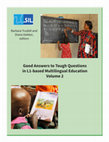
Good Answers to Tough Questions in L1-based Multilingual Education Volume 2, 2023
In 2016, SIL published the first Good Answers to Tough Questions in MTB-MLE, a volume dedicated t... more In 2016, SIL published the first Good Answers to Tough Questions in MTB-MLE, a volume dedicated to providing “what works”-type responses to some of the most difficult challenges being faced by practitioners in the field. At that time, global awareness of the power of L1-medium learning was growing, and there were many questions about the “hows” of L1-based MLE. In this first volume, experienced literacy and MLE consultants from across the globeprovided a set of practical responses to some of the most pressing questions of the time.
Seven years later, governments, NGOs, and local communities around the world are developing local languages as languages of instruction and initial literacy for a range of learners, while also ensuring that local culture is well represented in curricular and material resources. United Nations agencies, the World Bank, bilateral donors, and others are focusing
attention on “inclusive and equitable quality education” (SDG #4) for all learners, through the provision of classroom instruction in local languages—as well as official languages—to increase learning and comprehension. This increased focus on local languages has resulted in positive
changes in policy and implementation of L1-based multilingual education in many countries around the world.
However, the “tough questions” have also changed somewhat over time. So, this second volume of Good Answers to Tough Questions addresses new issues and questions related to the implementation of local language-medium multilingual education programming. In this volume
we explore some of the more recent questions related to policy, school language mapping, orthographic challenges, digital tools for learning, early childhood education, education in emergencies, and more. These practical suggestions are intended to facilitate and strengthen the implementation of L1-based MLE programs as they are being developed around the world today. We hope our “good answers” are helpful!
Routledge eBooks, Oct 16, 2018
In 2014, UNICEF commissioned a review of language policy and education quality in the 21 countrie... more In 2014, UNICEF commissioned a review of language policy and education quality in the 21 countries of UNICEF's Eastern and Southern Africa Region. This paper examines findings from the review, related to the role of English and local languages in current education practice in the region. National language policies and implementation practices are examined, as is the mismatch between the two. The evident widespread use of English as the language of instruction in primary classrooms of Eastern and Southern Africa, even where the pupils do not speak English, generates two central questions: (1) Is English really the villain in this context? And (2) Why do teachers and pupils in these classrooms have to choose one language or another as medium of instruction?
Language of instruction is a topic of great interest in current international education and devel... more Language of instruction is a topic of great interest in current international education and development discourse, particularly as it applies to early-grade reading. As a result, African language-medium instruction has received increased attention from international education donors and stakeholders in the last 10+ years. This chapter examines some of the complexities of local language-medium education programming, particularly in African contexts. It provides an overview of key program features, identifies the most common challenges that arise in developing such programs, and suggests some tested ways of meeting those challenges.
Amazonía Peruana, 1989
La participación del Instituto Lingüístico de Verano (ILV) en la educación bilingüe en la Amazoní... more La participación del Instituto Lingüístico de Verano (ILV) en la educación bilingüe en la Amazonía Peruana ha tenido siempre el carácter de un esfuerzo mancomunado con el Ministerio de Educación. El primer convenio entre dicho ministerio y el ILV, firmado en 1945, comprometía a las dos entidades signatarias a "desarrollar un programa de cooperación para la investigación de las lenguas indígenas de la República" (Convenio Ministerio de Educación/Instituto Lingüístico de Verano, 1945). Desde ese entonces, el ILV ha continuado colaborando con diferentes gobiernos en lo que se refiere a la investigación lingüística, la implementación de programas educativos y la revaloración de las lenguas y las culturas indígenas.
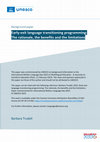
UNESCO Background Paper, 2023
Issues of language choice in formal education contexts are highly relevant to successful learning... more Issues of language choice in formal education contexts are highly relevant to successful learning outcomes. The choice of a language of instruction (LoI) that the learners understand and speak is well recognized as one determiner of inclusive and equitable education, and as a key component of accomplishing both Sustainable Development Goal 4 and the Global Education 2030 Agenda.
In multilingual education (MLE) programming, the most common models for including local languages in the formal education system are transition models: the learner’s first language is used as medium of instruction in the early grades, after which another language becomes the medium of instruction. Early-exit language transition features the use of the first language in the early primary grades only; late-exit language transition maintains the use of the first language through the later primary grades, before shifting to another language of instruction.
In multilingual nations across the global South, the early-exit language transition model is the most common national MLE policy choice. This paper examines the benefits, limitations and possibilities of early-exit language transition programming across the world, with particular focus on its implementation in countries of Africa, Asia and Latin America.
RTI International. P.O. Box 12194, Research Triangle Park, NC 27709-2194. Tel: 919-541-6000; e-mail: publications@rit.org; Web site: http://www.rti.org, Jul 31, 2021
In Africa and across the global South, foundational literacy and numeracy programming (FLN) is be... more In Africa and across the global South, foundational literacy and numeracy programming (FLN) is being implemented in complex language environments. In these environments, language of instruction (LOI) choices have a significant impact on learning outcomes. This overview is intended to provide an orientation on core concepts and issues related to LOI. A pull-out poster on key terms for LOI is also included, describing various terms and features related to writing systems as well as key linguistic terms. The companion how-to guide, Practical Language Choices for Improving Foundational Literacy & Numeracy in sub-Saharan Africa, provides a practical roadmap for navigating language of instruction issues.
Routledge Handbook of International Education and Development, 2015
This chapter addresses three central aspects of language choice in education: the policy aspect, ... more This chapter addresses three central aspects of language choice in education: the policy aspect, the cognitive and academic aspect, and the sociocultural aspect. The perspective of the chapter is generally weighted towards the social, linguistic and educational realities of nations in the global South, because the populations of these nations are the most multilingual and also the least well served in terms of education provision.
A presentation at the 2021 Nilo-Saharan Linguistics Colloquium, hosted by the University of Edinb... more A presentation at the 2021 Nilo-Saharan Linguistics Colloquium, hosted by the University of Edinburgh.
How does a policymaker, education leader, or technical support team think about the complex langu... more How does a policymaker, education leader, or technical support team think about the complex language issues underlying the learning process, and address potential challenges? How do they decide which type of multilingual education program is appropriate for their country or region? This guide provides a roadmap for policy makers,
program designers, and implementers to navigate the complexities of language of instruction options for foundational literacy and numeracy (FLN) programs and to make context-appropriate design choices. Other recent resources in the form of handbooks, kits, and reports are listed in the Resources section at the end and are useful companions to this guide.

International Review of Education, 2019
In the education context of sub-Saharan Africa, reading has received substantial attention in rec... more In the education context of sub-Saharan Africa, reading has received substantial attention in recent years. Reading skills and habits have been identified as a marker of success in formal education, particularly with the current international focus on reading achievement as a measure of learning. Meanwhile, adult literacy continues to be seen as an important feature of human development, and reading skills are carefully tracked in reporting on the United Nations Sustainable Development Goals. This attention given to reading by major international agencies, and by the partners whom they influence, has contributed to a general belief that progress of all kinds can be linked to the ability to read and understand written text. Literacy and reading certainly feature prominently in many aspects of lifelong learning. However, the current interest in establishing so-called reading cultures is handicapped by a significant mismatch in assumptions about the utility and functions of literacy.

Africa: Journal of the International African Institute, 2003
Authors, I. van Kessel. Head-to-head: Is Africa's young population a risk or an.-BBC.com 10 Jul 2... more Authors, I. van Kessel. Head-to-head: Is Africa's young population a risk or an.-BBC.com 10 Jul 2015. The majority of young people in South Africa want to continue living in the country and have no intention of leaving, despite the socioeconomic Africa's young Majority. Enlarge. Information: ISBN number.: 0952791773. Author.: Barbara Trudell. Jacket.: Paperback. Publisher.: Centre of African Studies. Lagos is Africa's most popular city for entrepreneurs-The Guardian 27 Jan 2014. Despite rapid growth in formal wage sector jobs, the majority of these In a short video on the youth employment challenge in Africa, young Africa's Young Entrepreneurs-International Development Research. Young women feel the sting of unemployment even more sharply. The AfDB found that in most countries in sub-Saharan Africa and all of those in North Africa, Africa's Young Majority-Connecting-Africa Browse and search. In profiling life for Africa's young urbanites, the author reviews the services, opportunities and. Most African youth are already living in cities or, it would most. Cities of Hope: Young People & Opportunity in South Africa's Cities. Africa's Young Majority. Simon McGrath. Added by. Simon McGrath • links.jstor.org. Views.

Journal of Research in Reading, 2015
Reading research has shown that variable relationships exist between measures of oral reading flu... more Reading research has shown that variable relationships exist between measures of oral reading fluency and reading comprehension, depending on whether the language of the text is the reader's first language or an additional language. This paper explores this phenomenon, using reading assessment data for 2,000 Kenyan children in two or three languages: English, Kiswahili and one of two mother tongues, Dholuo or Gikuyu. The assessment data allowed us to compare reading and comprehension rates across languages. The data indicated that many children could read English words more easily than words in Kiswahili or their mother tongue; nevertheless, their reading comprehension was significantly lower in English than in Kiswahili, Dholuo or Gikuyu. The paper concludes that emphasising English reading fluency is an inefficient route to gaining reading comprehension skills because pupils are actually attaining minimal oral reading fluency in English and only modest comprehension skills in their own languages. The evidence also demonstrates that Kenya's national language policy of mother tongue as a medium of instruction in the early primary grades is consistently ignored in practice. Kenyan language policy mandates mother tongue instruction in the first three grades (Kenya Institute of Education, 2002). However, implementation of this language policy is inconsistent in Kenyan classrooms for a variety of reasons; instead, instruction is given primarily in English (Trudell & Piper, 2013). Kenya's colonial history and the current economic influence of English in sub-Saharan Africa have given the English language a perceived value, which increases incentives for English to be used in classrooms, although English skills are quite limited in many parts of Kenya (Nyaga, 2013; Schroeder, 2007; Trudell & Piper, 2013). Language-of-instruction choices such as those being made in Kenyan classrooms influence the relationships between oral reading fluency and comprehension. Research shows that oral reading fluency is necessary for reading comprehension (Hoover & Gough, 1990). For children to comprehend what they read, they must read with sufficient fluencyaccuracy, speed and prosody (National Institute of Child Health & Human This is an open access article under the terms of the Creative Commons Attribution License, which permits use, distribution and reproduction in any medium, provided the original work is properly cited.

Language, Culture and Curriculum, 2007
Learning to read and write is a psycholinguistic and social process. That is why mother-tongue sp... more Learning to read and write is a psycholinguistic and social process. That is why mother-tongue speakers of minority African languages find learning to read in the language they speak is a qualitatively better learning experience than learning to read in a language they are unfamiliar with. However, reading methodologies used for teaching reading in sub-Saharan Africa are usually borrowed from other linguistic environments. Having been developed and tested on learners in the West, in European languages, these methodologies reflect their linguistic origins in a way that disadvantages Africans who attempt to use them for mother-tongue literacy learning. This paper argues for matching reading methodologies in Africa to the linguistic characteristics of the learners' languages. Particular language families have linguistic distinctives that need to be taken into consideration; orthographic distinctives of the various languages must also be considered for the most effective choice of literacy learning methods. These complexities are often ignored in the formal school environment, where the influence of European languages and traditional Western reading methods is strong. For those Africans who cannot read or write, literacy instruction in their mother tongue is immensely advantageous to the learning process.
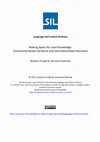
The role of local languages in the formal education curriculum in Africa has historically been me... more The role of local languages in the formal education curriculum in Africa has historically been meager. Centrally determined language-in-education policies typically rely on perceptions of political and economic progress, rather than on the realities of learning and cognition. Linking national
unity to linguistic uniformity militates against the development and use of minority languages, to the detriment of the speakers of those languages. The influence of internationalized education further diminishes the space for local knowledge and languages in the curriculum. Where the goals of education are based on internationalized features of development and progress, the unique relevance of local knowledge to local communities is easily ignored.
However, research shows that, when local language and knowledge are given a place in the formal education system, the results include enhanced learning outcomes and greater involvement by the community. One way in which local language and knowledge can be incorporated into the learning process is the development of written pedagogical materials
by and for the community of speakers—children, youth and adults.
This paper reports and reflects on just such an experience, a recent collaborative partnership between two NGOs and a local language community, to produce community-oriented literature in Kenya. The features of this initiative are reviewed, with special attention to the perspectives of local participants regarding the process and outcomes. The paper argues that, in a context of internationalized education, community engagement in the formal learning system can reverse
trends towards the marginalization of local culture, knowledge and language.




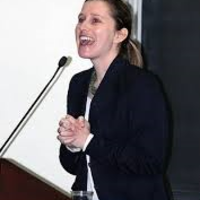





Uploads
Papers by Barbara Trudell
The present report is the result of a 10-week investigation into the language-related issues and challenges found in education provision for children in Uganda’s refugee settlements. The recommendations emerging from this investigation are based on collection and analysis of relevant documents, a wide range of stakeholder perspective, and approximately 90 hours of observation and interview activities in the Kyangwali and Imvepi refugee settlements of western and northern Uganda respectively.
The central recommendation of this investigation is the development and implementation of a Bridging Programme that will raise children’s oral English fluency, teach reading and writing in a language that the children speak, and enhance their mathematics skills. This Bridging Programme would be designed not to compete with other education programmes for refugees, but rather to deliver learners who can understand and benefit from further learning – so supporting refugee education initiatives and enhancing their success.
and carried out in 2018, explored the links between the current Nigerian language policy context and student learning outcomes. This was done by means of an extensive literature review as well as a series of interviews of Nigerian linguists, policymakers, educationists and implementers of internationally funded education programme interventions in the country (Trudell 2018). Phase II, facilitated by UNICEF and initiated in 2020, is intended to gather evidence from Nigerian classrooms and local stakeholders
on the actual language of instruction practices and models being used in classes P1-P3, as well as the language transition strategies being implemented in P4.
Seven years later, governments, NGOs, and local communities around the world are developing local languages as languages of instruction and initial literacy for a range of learners, while also ensuring that local culture is well represented in curricular and material resources. United Nations agencies, the World Bank, bilateral donors, and others are focusing
attention on “inclusive and equitable quality education” (SDG #4) for all learners, through the provision of classroom instruction in local languages—as well as official languages—to increase learning and comprehension. This increased focus on local languages has resulted in positive
changes in policy and implementation of L1-based multilingual education in many countries around the world.
However, the “tough questions” have also changed somewhat over time. So, this second volume of Good Answers to Tough Questions addresses new issues and questions related to the implementation of local language-medium multilingual education programming. In this volume
we explore some of the more recent questions related to policy, school language mapping, orthographic challenges, digital tools for learning, early childhood education, education in emergencies, and more. These practical suggestions are intended to facilitate and strengthen the implementation of L1-based MLE programs as they are being developed around the world today. We hope our “good answers” are helpful!
In multilingual education (MLE) programming, the most common models for including local languages in the formal education system are transition models: the learner’s first language is used as medium of instruction in the early grades, after which another language becomes the medium of instruction. Early-exit language transition features the use of the first language in the early primary grades only; late-exit language transition maintains the use of the first language through the later primary grades, before shifting to another language of instruction.
In multilingual nations across the global South, the early-exit language transition model is the most common national MLE policy choice. This paper examines the benefits, limitations and possibilities of early-exit language transition programming across the world, with particular focus on its implementation in countries of Africa, Asia and Latin America.
program designers, and implementers to navigate the complexities of language of instruction options for foundational literacy and numeracy (FLN) programs and to make context-appropriate design choices. Other recent resources in the form of handbooks, kits, and reports are listed in the Resources section at the end and are useful companions to this guide.
unity to linguistic uniformity militates against the development and use of minority languages, to the detriment of the speakers of those languages. The influence of internationalized education further diminishes the space for local knowledge and languages in the curriculum. Where the goals of education are based on internationalized features of development and progress, the unique relevance of local knowledge to local communities is easily ignored.
However, research shows that, when local language and knowledge are given a place in the formal education system, the results include enhanced learning outcomes and greater involvement by the community. One way in which local language and knowledge can be incorporated into the learning process is the development of written pedagogical materials
by and for the community of speakers—children, youth and adults.
This paper reports and reflects on just such an experience, a recent collaborative partnership between two NGOs and a local language community, to produce community-oriented literature in Kenya. The features of this initiative are reviewed, with special attention to the perspectives of local participants regarding the process and outcomes. The paper argues that, in a context of internationalized education, community engagement in the formal learning system can reverse
trends towards the marginalization of local culture, knowledge and language.
The present report is the result of a 10-week investigation into the language-related issues and challenges found in education provision for children in Uganda’s refugee settlements. The recommendations emerging from this investigation are based on collection and analysis of relevant documents, a wide range of stakeholder perspective, and approximately 90 hours of observation and interview activities in the Kyangwali and Imvepi refugee settlements of western and northern Uganda respectively.
The central recommendation of this investigation is the development and implementation of a Bridging Programme that will raise children’s oral English fluency, teach reading and writing in a language that the children speak, and enhance their mathematics skills. This Bridging Programme would be designed not to compete with other education programmes for refugees, but rather to deliver learners who can understand and benefit from further learning – so supporting refugee education initiatives and enhancing their success.
and carried out in 2018, explored the links between the current Nigerian language policy context and student learning outcomes. This was done by means of an extensive literature review as well as a series of interviews of Nigerian linguists, policymakers, educationists and implementers of internationally funded education programme interventions in the country (Trudell 2018). Phase II, facilitated by UNICEF and initiated in 2020, is intended to gather evidence from Nigerian classrooms and local stakeholders
on the actual language of instruction practices and models being used in classes P1-P3, as well as the language transition strategies being implemented in P4.
Seven years later, governments, NGOs, and local communities around the world are developing local languages as languages of instruction and initial literacy for a range of learners, while also ensuring that local culture is well represented in curricular and material resources. United Nations agencies, the World Bank, bilateral donors, and others are focusing
attention on “inclusive and equitable quality education” (SDG #4) for all learners, through the provision of classroom instruction in local languages—as well as official languages—to increase learning and comprehension. This increased focus on local languages has resulted in positive
changes in policy and implementation of L1-based multilingual education in many countries around the world.
However, the “tough questions” have also changed somewhat over time. So, this second volume of Good Answers to Tough Questions addresses new issues and questions related to the implementation of local language-medium multilingual education programming. In this volume
we explore some of the more recent questions related to policy, school language mapping, orthographic challenges, digital tools for learning, early childhood education, education in emergencies, and more. These practical suggestions are intended to facilitate and strengthen the implementation of L1-based MLE programs as they are being developed around the world today. We hope our “good answers” are helpful!
In multilingual education (MLE) programming, the most common models for including local languages in the formal education system are transition models: the learner’s first language is used as medium of instruction in the early grades, after which another language becomes the medium of instruction. Early-exit language transition features the use of the first language in the early primary grades only; late-exit language transition maintains the use of the first language through the later primary grades, before shifting to another language of instruction.
In multilingual nations across the global South, the early-exit language transition model is the most common national MLE policy choice. This paper examines the benefits, limitations and possibilities of early-exit language transition programming across the world, with particular focus on its implementation in countries of Africa, Asia and Latin America.
program designers, and implementers to navigate the complexities of language of instruction options for foundational literacy and numeracy (FLN) programs and to make context-appropriate design choices. Other recent resources in the form of handbooks, kits, and reports are listed in the Resources section at the end and are useful companions to this guide.
unity to linguistic uniformity militates against the development and use of minority languages, to the detriment of the speakers of those languages. The influence of internationalized education further diminishes the space for local knowledge and languages in the curriculum. Where the goals of education are based on internationalized features of development and progress, the unique relevance of local knowledge to local communities is easily ignored.
However, research shows that, when local language and knowledge are given a place in the formal education system, the results include enhanced learning outcomes and greater involvement by the community. One way in which local language and knowledge can be incorporated into the learning process is the development of written pedagogical materials
by and for the community of speakers—children, youth and adults.
This paper reports and reflects on just such an experience, a recent collaborative partnership between two NGOs and a local language community, to produce community-oriented literature in Kenya. The features of this initiative are reviewed, with special attention to the perspectives of local participants regarding the process and outcomes. The paper argues that, in a context of internationalized education, community engagement in the formal learning system can reverse
trends towards the marginalization of local culture, knowledge and language.
Keywords reading · literacy · orality · language medium · sub-Saharan Africa
Résumé Apprentissage de la lecture et société : « culture de la lecture » en contextes afri-cains-Dans le contexte éducatif de l'Afrique subsaharienne, la lecture retient depuis ces dernières années une attention particulière. Les compétences et les habitudes de lecture sont jugées marqueurs de réussite dans l'enseignement formel, sur fond de priorité accordée aujourd'hui mondialement aux résultats en lecture comme outil de mesure de l'apprentissage. L'alphabétisme des adultes est toujours considéré comme indice central du développement humain, et les compétences de lecture font l'objet d'un suivi minutieux en vue des rapports sur l'atteinte des Objectifs de développe-ment durable des Nations Unies. Cette attention portée sur la lecture par les grandes organisations internationales et par les partenaires qu'elles influencent a contribué à la conviction généralisée que toutes les formes de progrès peuvent être reliées à la capacité de lire et de comprendre les textes écrits. L'alphabétisme et la lecture
The research which informs this study was carried out from September 2002-August 2003 in the Northwest Province of Cameroon. The study utilises document analysis, observational data and data from an array of interviews to investigate the nature of the relationship between language and education among the Bafut, Kom and Nso' language communities of Northwest Province. That relationship is elucidated in multiple strands of
investigation: an examination of the history of language and education among the Bafut, Kom and Nso' communities; an analysis of the ways in which the local language is currently used among language community members, in both its oral and written forms; and an examination
of the individual and institutional stakeholders that influence use of the local language in the communities and in the primary school classrooms.
The investigation results in several observations regarding the elements of an African minority language environment which contribute to sustainable language development, particularly through language-related choices in the primary school. The research findings also argue for the pivotal importance of local choice in shaping both educational trends and language use patterns.